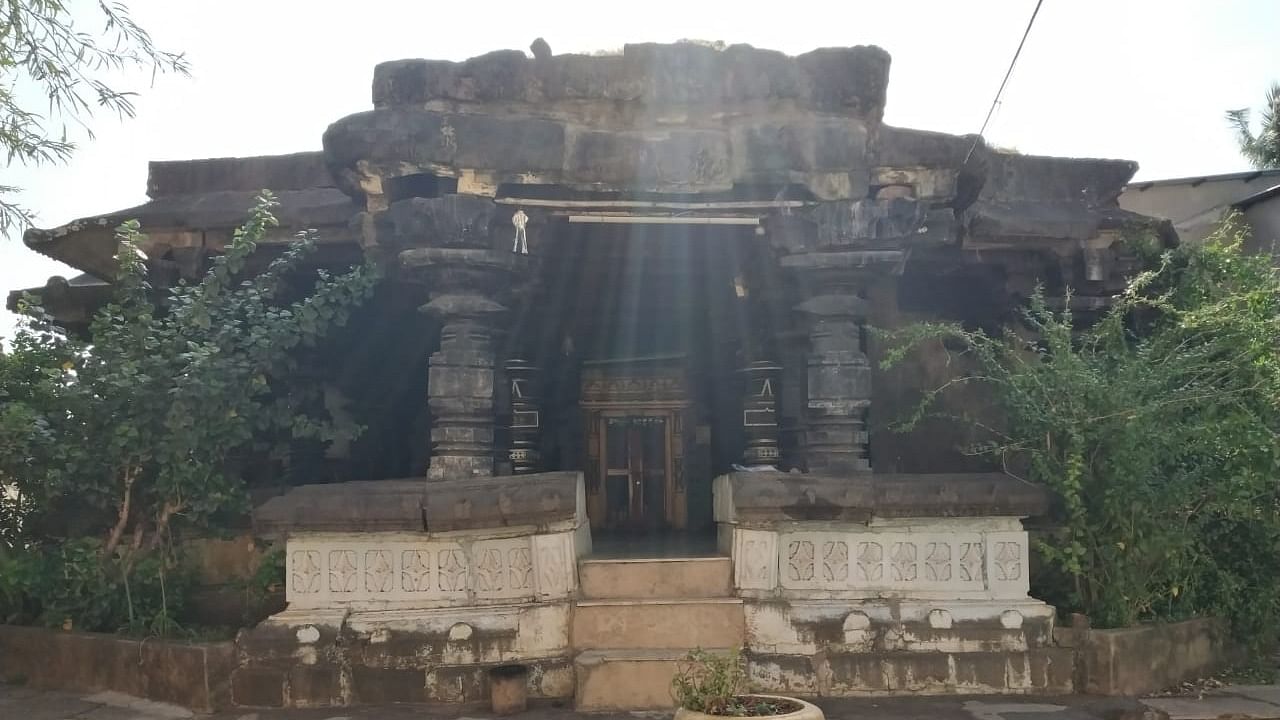

Known for its sugar factories and educational institutions, Sankeshwar town in Belagavi district has been a noted temple town for several centuries now. It boasts of some ancient temples which are significant from both historical and architectural points of view.
Some lesser-known temples of Sankeshwar, which have no much mention in the British gazetteers or documents, are the Shankarling Math, the Bhagwan Parshwanatha Jain Basadi and the Narayan temple, all in Math Galli.
Located on the banks of River Hiranyakeshi, Shankarling or the Shrimad Jagadguru Shankaracharya Karvir Math has a Shankarling temple. Established by Adi Shankaracharya around 1,000 years ago, the temple is spread over a large area within a strong-walled enclosure. It is a typical Ratta era structure built in the Rekha Nagara style which was popular then. Almost all the temples built during the reign of the Rattas in the Belagavi region are in the same style.
The main temple is divided into four parts- a rangamantapa, a navaranga, an antharala and a garbhagriha. One can enter the temple through the rangamantapa with approach from three sides, each covered with a porch. The rangamantapa has a large circular raised platform leading to the navaranga.
The ceiling of the navaranga bears floral carving and has openings on two sides through a porch. One of the porches has a beautifully carved ceiling with nine square panels, each having varied floral motifs. A large door from this porch leads to the river front.
The navaranga leads to the antharala followed by the garbhagriha having a large Shivlinga.
The main temple has been constructed using black cist stone with carvings on the ceilings, door frames and the 38 pillars. Currently, only a part of the original stone praakar (courtyard) is intact while the remaining has been rebuilt using brick masonry.
Since the temple is located on the river bank, it is susceptible to flooding in the monsoons. In 2019, the temple had submerged up to 8 feet in the flood water. Later, the Shikhara was painted and the door jambs were covered with brass. A portion of the praakar was recently reconstructed using modern construction techniques but this offers a patchy look.
Apart from the main temples, there are several smaller temples within the precincts of this complex including the Sharadamba Mata temple which has recently been renovated.
Jain basadi
Near to this Math is an ancient Jain basadi. This is yet another polygon-shaped structure with Ratta style of architecture and has a porch, navaranga, antharala and the garbhagriha. The main temple stands just three feet above the ground and has an idol of Bhagwan Parshwanath in a Kayotsarga pose (standing) with a prominent hooded snake above.
While the navaranga has carved pillars and roof, the courtyard has a newly constructed 30 feet tall Manastambha and a new temple. Standing on black alluvial soil and close to river Hiranyakeshi prone to floods, the external walls and other portions have deteriorated over the years.
Narayan temple
The third temple hidden on the same street is the Narayan temple. The temple privately owned by the Toro family represented by Babu Toro is said to have been given to them by the Shankaracharya Math several decades ago.
The main structure of this temple too is in Ratta style with multi-angular appearance. The rangamantapa here has three openings. But one among them has been kept closed to support a damaged beam. There are 12 pillars inside the temple and a few beams in the rangamantapa have developed cracks.
The ceiling of the rangamantapa has elaborate carvings in two layers with the central layer having a floral pattern within an octagonal star-shaped carving. The ceiling also has carvings of mythical animals and figurines.
On one panel, we can see a male and female deity riding a bull. On another, there is a ram while a third one has a pig-like figurine (could be a depiction of Varaha avatar of Lord Vishnu). The door of the sanctum is flanked by two small niches, one with Kartikeya and the other by Ganesha.
On the left wall of the inside chamber is a large-sized inscription in Halegannada. It tells in detail about the Laxmi-Narasimha temple being granted by the Ratta king Kartavirya, the Mahamandaleshwar of the Kalyan Chalukyas of Savadatti, towards one Ashesh Mahajan of Brahmapuri as also a monetary grant towards the Chikkeshwar Devasthan. Images of tiger heads (Vyaghramukhas ) can be seen carved on this wall.
The town is also famous for the Nilgar Ganapati (established by the Nilgar family) which attracts hundreds of devotees during Ganesh Chaturthi every year.
Although these temples let us know more about our history, they lack proper maintenance. So, it is time we repair and conserve these temples, especially the Narayan temple. Also, these temples need to be studied in detail and documented.